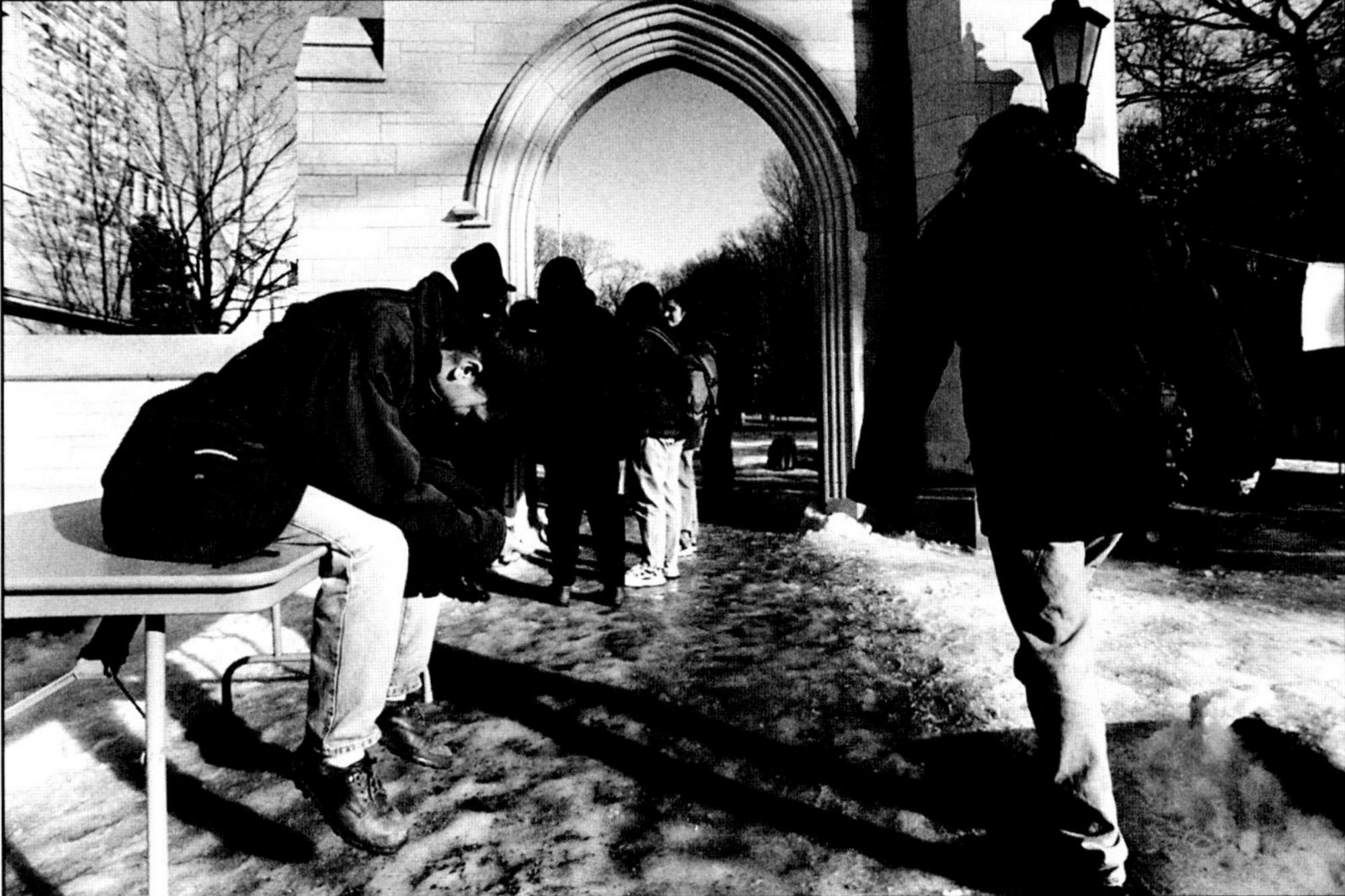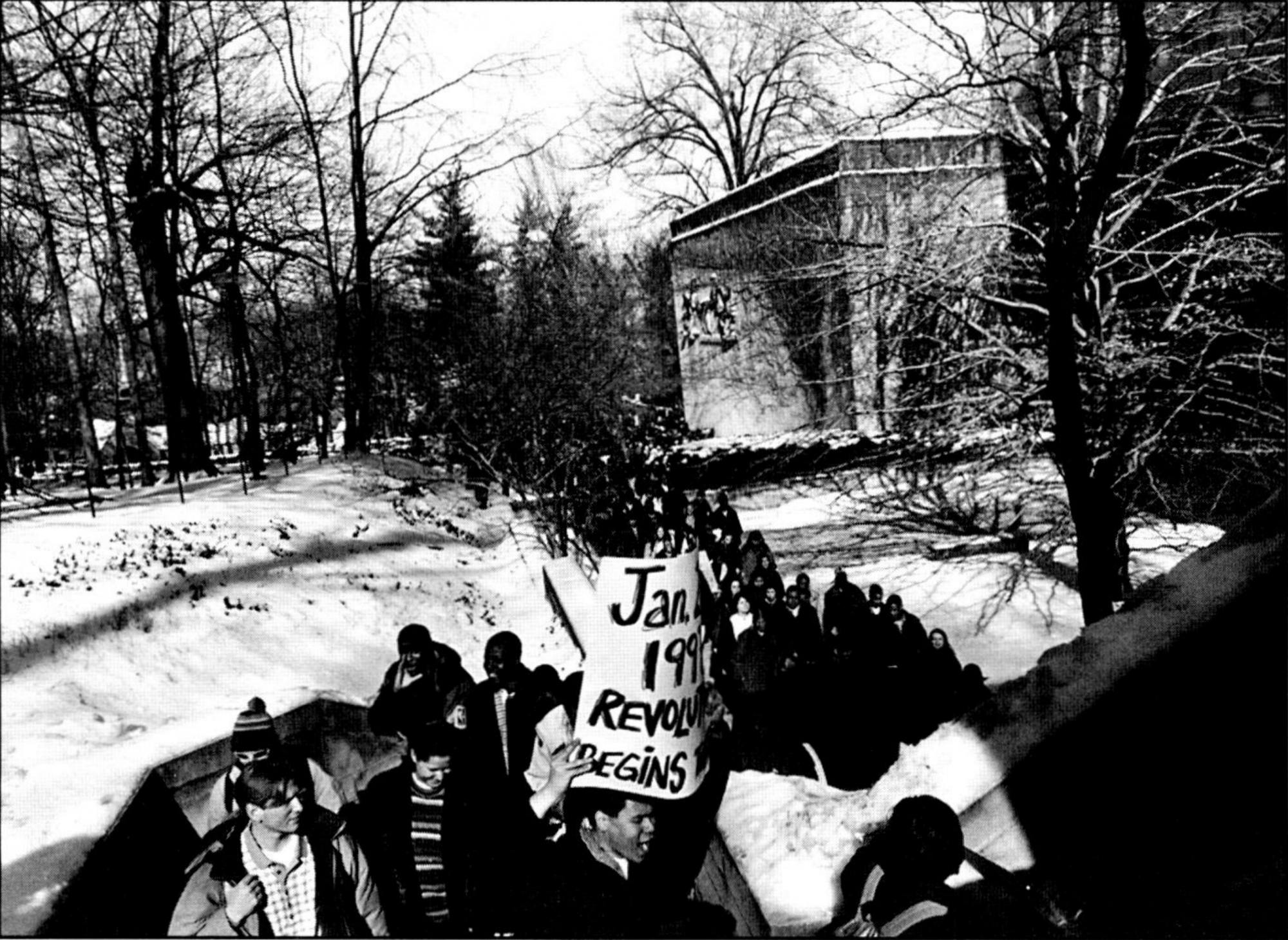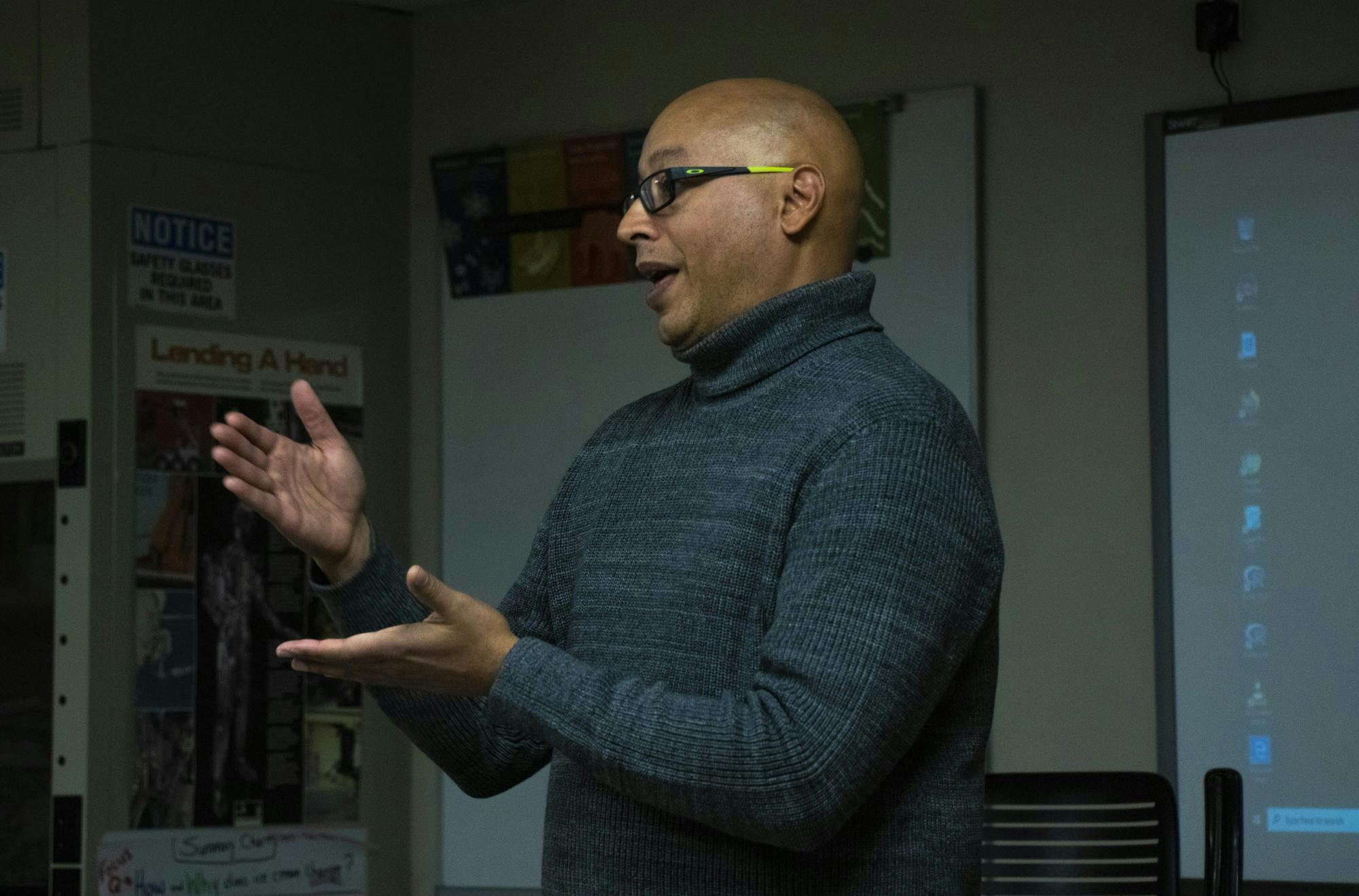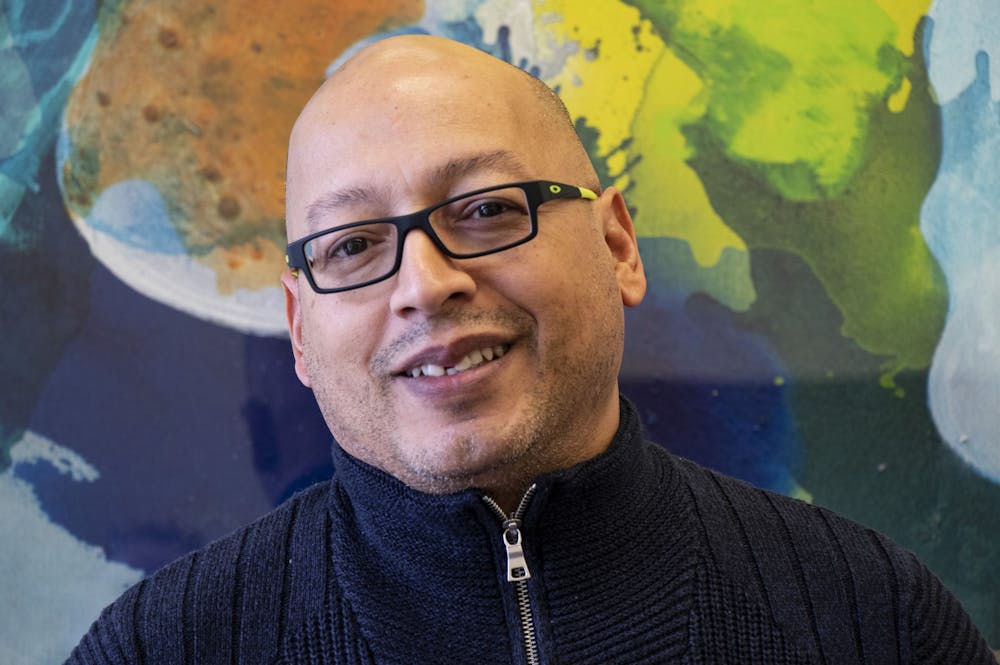Bruce Smail fought for LGBTQ and minority rights at IU as a graduate student in the ‘90s. He helped draft demands, organize a 1,000-person protest and convince the university to prioritize diversity.
This semester, Smail has returned to campus but instead of fighting for those rights as a student activist, he plans to do so as the interim director of the LGBTQ+ Culture Center.
The center has gone through a lot of changes since it started in 1995. So has Smail.
In 1990, Smail came out publicly as bisexual. In 2003, he was diagnosed with HIV. He has moved around four states, an island and Washington, D.C. working for four colleges, three HIV/AIDS organizations and the Centers for Disease Control and Prevention.
Smail is also serving as the special assistant to the Vice President of Diversity, Equity and Multicultural Affairs. Yolanda Treviño, assistant vice president of DEMA, said she knew Smail when he was studying at IU in the ‘90s.
“He was, and continues to be, an insightful individual who listens carefully and offers attainable recommendations and solutions,” Treviño said in an email.
Smail will be the interim director for the next 3 ½ years. Through his career, he has worked to support black, LGBTQ, HIV/AIDS and other minority communities, and this work will influence his approach to IU's culture center.
In 1997, Smail was part of a student coalition at IU that staged a 1,000-person protest on Martin Luther King Jr. Day to bring attention to a list of diversity-related demands for the university.According to a Jan. 21, 1997, article in the Indiana Daily Student, the demands were as follows:
1. The approval and implementation of a Latino Studies Department
2. The appointment of an Asian American Advocacy Dean
3. The maintenance and possible expansion of the Office of Diversity Programs
4. The funding and permanence of the GLB Student Support Services Office
5. The creation of an Asian culture center
6. An increase in both non-white and women faculty
7. The University-wide recognition of Martin Luther King Jr. Day
An article in the next day’s paper read, “Demands Met, 100%.” The student coalition's changes established what is now the Asian Culture Center and DEMA. IU also began its annual recognition of Martin Luther King Jr. Day and revised faculty-recruitment strategies to more fairly consider female and non-white applicants.
Smail said he was one of the six students who met with Kenneth Gros Louis, then-IU vice president and Bloomington campus chancellor, to reach these diversity goals.
“I was one of the few LGBTQ folks that were sitting on this committee,” Smail said. “I think we were successful because we came across from a very intersectional standpoint. We had all of the communities involved — we had international students, LGBTQ students, I think we even had students with disabilities that were on the committee.”
Smail identifies as a bisexual black man, but he said the Latino side of his family also contributes to his cultural identity. At IU, he said he wants to improve support for intersectional identities, allowing students to feel comfortable discussing multiple parts of their identity at any culture center.
“I’ve always celebrated all of my identities,” Smail said. “I have many, and we all do, but I’m not sure that we all celebrate that.”
This sense of identity has guided Smail’s advocacy since the beginning of his career.


Smail was born and raised on Saint Croix, a tiny territory in the U.S. Virgin Islands. Its population count in the 2010 census was 50,601. According to university data, IU-Bloomington’s spring 2020 student enrollment is 41,294.
Saint Croix’s entire area is 84 square miles. It takes about an hour to drive from one end of the island to the other, left to right, according to Google Maps. Top to bottom, the drive is only 20 minutes.
“I can walk down the street right now in Saint Croix and people would say, ‘You’re Juanita Smail’s son,’” Smail said. “People know you. You’re very visible.”
He said LGBTQ issues are rarely discussed on the island, largely due to a lack of openly gay residents. When he was growing up, he only remembers seeing three LGBTQ islanders, all of whom were trans women. Smail said these women were the only impression of LGBTQ people he remembers from the time.
“They were called ‘anti-men,’” Smail said. “They were the image of someone who was gay.”
Smail left the island after high school. He attended The College of New Jersey, earning a bachelor’s degree in history in 1983 and a master’s degree in counseling and personnel services in 1987.
He soon started working at Boston University, coordinating programs for the university’s Minority Affairs Office. His next job at Colorado State University’s Black Student Services director involved similar work.
At the time, he focused mainly on supporting black students. His interest in working on LGBTQ issues came after he came out as bisexual.
Smail dated a man in college, and he came out privately to himself and his partner. However, he didn’t come out publicly until he was almost 30 due to a combination of traditional island customs and the widespread misunderstanding of the LGBTQ community in that time.
Smail said he has always had a strong connection with his family. Though his five siblings are spread out across four states, they try to get together frequently, and he often brings up extended family members in conversation.
His siblings grew up with the same limited impressions of the LGBTQ community as he did, and Smail was hesitant to share his sexuality with them.
In 1991, Smail’s father was in critical condition, and he and his siblings gathered to be with him while he was in the hospital. Smail tried to help his siblings cope with not knowing the results of their dad’s medical tests by using a personal metaphor.
He had recently taken an HIV test, which took two to three weeks for results. He told them waiting for the results was like waiting for an HIV test — it’s helpful to think of the worst case scenario while you’re waiting, just like how they were waiting to hear results about their dad’s health.
His siblings asked why he had taken an HIV test, and the conversation turned to Smail’s sexuality. Smail told them he was bisexual for the first time, and he said their reactions weren’t supportive.
“‘Did you sleep with someone that was a prostitute or something? Does that mean you’re going to start wearing dresses?’” Smail recalled his brothers asking.
Smail said his siblings didn’t understand much about HIV/AIDS or LGBTQ issues, and they assumed he had HIV and was gay, even though his HIV test results were negative and he is bisexual.
“They felt that they must have done something wrong that I became this way,” he said.
In the years after he came out, Smail worked in several HIV/AIDS and LGBTQ advocacy positions. He said when his family saw his advocacy work, they gained a greater understanding of both Smail’s identity and LGBTQ issues as a whole. He said they are much more accepting today.
“I felt like there was this huge barrier that was broken around discomfort around LGBTQ issues,” Smail said.

Early in 2003, Smail went to a physical exam he thought would be routine. He didn't know that his doctor had recently tested him for HIV due to a paperwork misunderstanding.
The test had come back reactive, a possible positive result that required further tests. Fifteen days later, it officially came back positive.
On his blog, Smail described his initial reactions to his HIV-positive status.
“There was nothing I could do to change my status at that point — there was nothing to feel guilty about — and I knew this was an opportunity to share yet another aspect of my life,” Smail wrote. “Despite the challenges I knew I would face as a person living with HIV, I also knew that I still had to love myself, share my story, and help others put a face to HIV.”
Smail’s HIV-positive status led him to work at multiple HIV/AIDS organizations, most recently as the deputy director of the Black AIDS Institute in Los Angeles.
He said he shares his story about living with HIV to decrease the stigma surrounding the disease. He advocates for those living with HIV who aren't able to share their stories, he said. While Smail makes it a priority to be open about his HIV status in the workplace, he said people in less diversity-focused jobs may still fear consequences if they disclosed this information publicly.
Smail said his openness about HIV has at times put him in difficult and even dangerous situations.
More than 20 years after Smail left his small island for college, he returned as the CEO of an HIV/AIDS organization in Saint Croix.
One day when Smail was walking to a bakery around the corner from his house, a man yelled an anti-gay slur and threatened to kill him.
Smail ignored the man and continued into the bakery, but the man yelled at him again on his way out.
Smail reported the incident to the Saint Croix police, but he said the police officer didn’t seem to understand why he’d be reporting such an incident. They never did anything about it.
“I guess I need to be killed first before you would do anything about it,” Smail remembers thinking.
Smail said he knows of one LGBTQ islander who was killed during his time working there. He said the police did not view it as a hate crime.
“It was just one of those things that they wanted to kind of brush under the rug,” Smail said.
Smail said his and his coworkers’ presence at the HIV/AIDS organization was important in bringing visibility to LGBTQ individuals on the island.
“If you don’t have the visibility, it’s easy to kind of push it under the rug — ‘That’s not real, that’s not happening here,’” Smail said.
IU’s campus has a different social environment than the small island of Saint Croix. The LGBTQ+ Culture Center’s focus has turned toward activism and education rather than discrimination in recent years. But, Smail said there’s still a lot of progress to be made.
Danielle Hernandez, graduate assistant at the center, said Smail has already suggested several changes. She said he’s interested in co-sponsoring events with other culture centers on campus and providing resources for other IU campuses. Hernandez said Smail also wants to make sure all LGBTQ groups have relevant programs all year. He already changed the bathroom sign in the center, which previously had symbols of a man and woman, to be more accepting of nonbinary individuals.
“He’s here for three years, which is enough time to make some real change,” Hernandez said. “He’s giving everybody not just the freedom to think big, but he’s pushing us to go bigger on everything.”
Smail said in the past, the center has mainly pursued projects students brought up to the staff. He said he wants the center to be more proactive with consistent programming and services, such as a regular diversity training team to educate groups about navigating LGBTQ issues like pronoun use.
“How do we make our voice visible enough that people feel like, ‘Hey, I can come to this center because you’re also addressing issues that are relevant to me’?” Smail said.
Smail said he’s excited to see where the center will go in the next 3 ½ years.
“I truly want to see this space grow to that level of supporting all of our community,” Smail said. “Our community is just so diverse on so many levels around sexual identity, gender identity, and the intersections with race and ability and all these other areas.”




